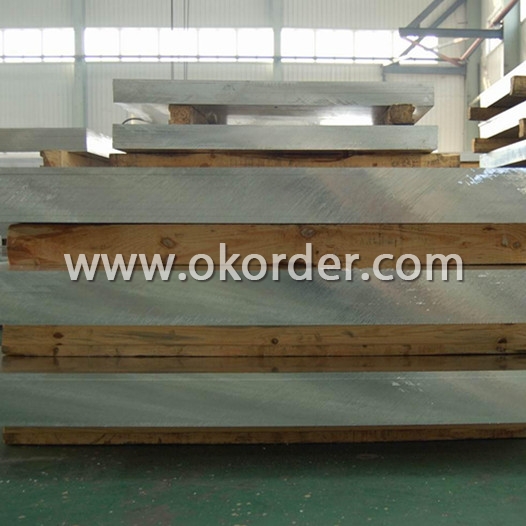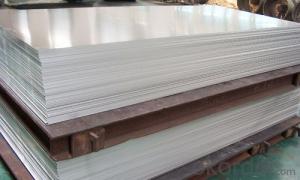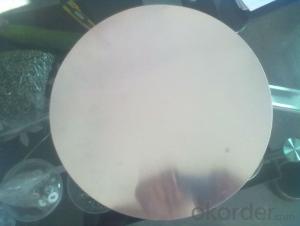Aluminum Sheets for Teardrop - Aluminum Plates 3003
- Loading Port:
- China Main Port
- Payment Terms:
- TT or LC
- Min Order Qty:
- 5 Tons m.t.
- Supply Capability:
- 10000 Tons Per Month m.t./month
OKorder Service Pledge
OKorder Financial Service
You Might Also Like
1 Specifications of Aluminum Plates 3003
|
Alloy Number |
AA1050 , AA1060 ,AA1070 ,AA1100 etc. |
|
Temper |
H12, H14, H16, H18, H22, H24, H26, H32, HO, F |
|
Thickness |
0.1mm – 500mm |
|
Width |
10mm- 2200mm |
|
Standard |
GB/T3880-2006, ASTM, ISO, EU standard |
Special Specification is available on customer’s requirement

2 Usage/Applications of Aluminum Plates 3003
Aluminum Plates is between 0.1 mm and 500mm in thickness and has a wide variety of uses in the construction industry including aluminium siding and roofing. Sheet is also used widely in construction, decoration, transport applications and other various industrial filed, such as automobile body panels, airframes, curtain walls and the hulls of boats etc.
CNBM produces aluminum plates which meets the highest standards in its own mill while save the cost. Our strong quality control term bring you the most-qualified products. And with state-of-the-art equipment, and the state owned company background, we have to say, you will understand why there are so many company choose CNBM to be their supplier. CNBM aluminum complying with YS/T 429-2000(Chinese Industry Standard),GB/T 3880,EN485,ASTM B209.

3 Packaging & Delivery of Aluminum Plates 3003
Packaging:Seaworthy package, bubble plastic bag inside, anti-moisture paper wrapped outside, covered with cartons, on wooden pallets, in containers. Pallet weight: Max. 2.30 tons.
Shipment:the goods will be delivered in 40 days after getting the buyer's payment.

4 Production Flow of Aluminum Plates 3003
Rolling--Annealing--Slitting--Sawing, Cut-To-Length, Shearing
- Q: I have a lot of old aluminum cake pans, coffee pots, pots and pans and various old nuts and bolts made of aluminum. Would it be worth it to scrap them? They really aren't usable for cooking anymore. They are clean.
- Aluminum is around 80 cents - 1$ per lb depending on grade. For current pricing you can try www.scrapmetalpricesandauctions.c...
- Q: This question asks for a comparison of aluminum sheets with other common materials used in building insulation, focusing on their properties and performance.
- <p>Aluminum sheets are lightweight and have excellent thermal conductivity, which can be both an advantage and a disadvantage in insulation. They reflect heat well, making them useful in radiant barrier applications, but they are poor insulators as they do not trap heat. In contrast, materials like fiberglass, cellulose, and mineral wool have lower thermal conductivity and are more effective at reducing heat transfer. These materials are better at insulating as they trap air, which is a poor conductor of heat. Foam insulation, such as polyurethane and polystyrene, also offers good thermal resistance due to their closed-cell structure. Overall, aluminum sheets are not typically used as primary insulation but can be effective in specific applications where heat reflection is desired.</p>
- Q: Hi I am getting a laptop pretty soon and have pretty much decided on a Mac. But really a white macbook is $1150, and aluminum is $1400. And just so no one says this, the white one is updated with all the same hardware(Advanced graphics, etc.) I want to get it asap so the $250 would mean about 2 months longer which would kind of be a drag. I also understand the aluminum doesn't have a firewire port, but idk what the hell that even is so can someone explain what it is and why I would care about it. Basically, is it worth the 2 months and $250 for the aluminum. Thanks.
- I've been researching this same thing. what I've learned is the new one pice aluminum body model is much stronger and built with a fall censer to protect the hard drive if the unit should be dropped. The screen is also lit by LED which is brighter and lasts longer than conventional screens. Save the extra $250 for it, you wont regret it. Check out the link, it clearly defines why ALUMINUM IS BETTER.
- Q: 1100 scope of application of aluminum plate
- 1100 aluminum plate is generally used in utensils, heat sink, caps, printing plates, building materials, heat exchanger components, but also can be used as deep stamping products. It is widely used in various fields ranging from cooking utensils to industrial equipment
- Q: Can aluminum sheet be used for aerospace applications?
- Certainly, aluminum sheet finds application in the aerospace industry. Owing to its advantageous characteristics, including being lightweight, highly robust, and resistant to corrosion, aluminum is extensively employed in this sector. It is frequently utilized in the fabrication of aircraft fuselages, wings, and structural elements. Aluminum sheets are commonly employed in the production of aircraft panels, where their exceptional strength-to-weight ratio facilitates enhanced fuel efficiency and greater payload capacity. Furthermore, aluminum sheets offer versatility and suitability for a wide range of aerospace applications due to their ease of forming, machining, and welding.
- Q: Can the aluminum sheets be painted or coated with a different color?
- Indeed, it is possible to paint or coat aluminum sheets with a different color. Aluminum, being a flexible material, lends itself well to the application of paint or coating in order to achieve the desired color or finish. This can be accomplished using a range of techniques, including powder coating, anodizing, or the use of liquid paint. These methods serve to both protect the aluminum sheet's surface and alter its color or appearance. The selection of the specific paint or coating will hinge upon the particular requirements and desired outcome. On the whole, the practice of painting or coating aluminum sheets is commonplace, granting opportunities for customization and aesthetic enhancement.
- Q: I need to make an aluminum cylinder out of 1/8 6061 plate and tube. I don't have a TIG setup and was considering using Bernzomatic aluminum soldering rods. The cylinder will be pressurized from 20-60 psi. Assuming a clean job, is this pressure ok? How much pressure can the joint take? Also, although the solder does not need flux, should i use it anyway?
- Whether that weld will be OK depends on the diameter of the cylinder. The force on the weld will be equal to the operating pressure time the radius of the cylinder, with the wall opposite the weld have an equal force. Divide that force by the thickness of the weld to figure the stress. You want to have a safety factor of about 3. As the Bernzomatic has either a brass or aluminum head, which would melt at the temperatures which are required for true welding (melting metals so that they flow together), you will be performing brazing with a Bernzomatic. I cannot comment on the strength of the brazing bond. The thickness of the brazing metal deposit depends on the strength of the brazing alloy, which I also cannot comment on. 6061 will melt at 1206°, which you will not approach with the Bernzo kit. A blowout of a metal cylinder at 60 psi could be pretty ugly. I suggest that you befriend someone who has a TIG welder and get their help. A properly welded 1/8 thick cylinder could handle about 660 psi with no problem. If you create a lap joint, using an outer strip of aluminum, and then band your cylinder with stainless steel hose clamps, you will be relying upon the brazing only to provide a gas seal. The strength would come from the hose clamps. You still need to do some calculation on forces involved. A 1/2 wide stainless hose clamp will probably hold back about 240 lb. of force with a comfortable margin of safety.
- Q: How do aluminum sheets perform in terms of formability?
- Aluminum sheets possess remarkable formability, renowned for their capability to be effortlessly molded and contoured into intricate configurations without encountering any cracks or fractures. The exceptional ductility and malleability of aluminum enable its transformation into diverse shapes, curves, and angles with relative simplicity. This inherent formability renders aluminum sheets highly adaptable for utilization in an array of applications, including automotive body panels, aircraft components, and architectural structures. Moreover, aluminum sheets exhibit commendable resistance to corrosion, further augmenting their performance in various environmental conditions. All in all, aluminum sheets amalgamate formability, strength, and durability, rendering them a favored choice across numerous industries.
- Q: Are the aluminum sheets suitable for manufacturing heat exchangers?
- Indeed, aluminum sheets prove to be fitting for the production of heat exchangers. Aluminum, being both lightweight and highly conductive, serves as an ideal option for heat transfer purposes. Its exceptional thermal conductivity facilitates efficient heat transfer, resulting in effective cooling or heating procedures. Moreover, aluminum's resistance to corrosion is of utmost importance for heat exchangers that encounter diverse fluids. Furthermore, the malleability and formability of aluminum sheets render them effortlessly malleable into the required designs for heat exchanger components. On the whole, aluminum sheets offer numerous benefits for the manufacturing of heat exchangers, thus making them a suitable selection for this particular application.
- Q: What is the shear strength of 101 aluminum sheets?
- The shear strength of 101 aluminum sheets can vary depending on various factors such as the thickness of the sheet, the specific alloy composition of the aluminum, and the manufacturing process used. Generally, 101 aluminum sheets have a shear strength ranging from 20,000 to 30,000 pounds per square inch (psi). However, it is important to note that this is a general range and specific values may vary. To obtain the exact shear strength of 101 aluminum sheets, it is recommended to consult the material's technical data sheet or reach out to the manufacturer for more accurate information.
1. Manufacturer Overview
| Location | Henan, China |
| Year Established | 1996 |
| Annual Output Value | Above US$200 Million |
| Main Markets | Mid East;Eastern Europe;North America |
| Company Certifications | ISO 9001:2000;ISO 14001:2004;OHSAS 18001 |
2. Manufacturer Certificates
| a) Certification Name | |
| Range | |
| Reference | |
| Validity Period |
3. Manufacturer Capability
| a) Trade Capacity | |
| Nearest Port | Shanghai |
| Export Percentage | 30%-50% |
| No.of Employees in Trade Department | 21-50 People |
| Language Spoken: | English;Chinese |
| b) Factory Information | |
| Factory Size: | Above 100,000 square meters |
| No. of Production Lines | Above 10 |
| Contract Manufacturing | OEM Service Offered;Design Service Offered |
| Product Price Range | Average |
Send your message to us
Aluminum Sheets for Teardrop - Aluminum Plates 3003
- Loading Port:
- China Main Port
- Payment Terms:
- TT or LC
- Min Order Qty:
- 5 Tons m.t.
- Supply Capability:
- 10000 Tons Per Month m.t./month
OKorder Service Pledge
OKorder Financial Service
Similar products
Hot products
Hot Searches
Related keywords




























